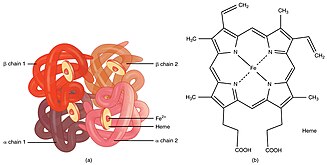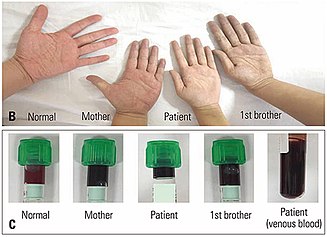Hemoglobin M disease
| Hemoglobin M disease | |
|---|---|
UV spectroscopy, DNA sequencing , etc. | |
| Treatment | No treatment is required |
Hemoglobin M disease is a rare form of hemoglobinopathy, characterized by the presence of hemoglobin M (HbM) and elevated methemoglobin (metHb) level in blood.[1] HbM is an altered form of hemoglobin (Hb) due to point mutation occurring in globin-encoding genes, mostly involving tyrosine substitution for proximal (F8) or distal (E7) histidine residues.[2] HbM variants are inherited as autosomal dominant disorders and have altered oxygen affinity.[3] The pathophysiology of hemoglobin M disease involves heme iron autoxidation promoted by heme pocket structural alteration.[4]
There exists at least 13 HbM variants, such as Boston, Osaka, Saskatoon, etc., named according to their geographical locations of discovery. Different HbM variants may give different signs and symptoms. Major signs include
Hemoglobin M disease is a

Signs and Symptoms
Hemoglobin M disease is usually asymptomatic. However, it may show symptoms such as
Pathophysiology
HbM is a rare methemoglobin group inherited in an autosomal dominant manner, resulting from
Different HbM Variants
At least 13 HbM variants involving alpha- or beta- or gamma-chains have been reported. Six variants, namely HbM Boston, HbM Iwate, HbM Saskatoon, HbM Hyde Park, HbFM Osaka and HbFM Fort Ripley, manifest proximal (F8) or distal (E7) histidine substitution by tyrosine at position alpha-58, alpha-87, beta-63, beta-92, gamma-63 and gamma-92 respectively. HbM Milwaukee-1 involves
Alterations in Oxygen Affinity

Under normal circumstances, the heme iron in ferrous state (Fe2+) is covalently bound to imidazole nitrogen of the proximal histidine (F8), and is able to bind to an oxygen molecule.[5]
Tyrosine substitution renders structural alteration of the heme pocket and promotes spontaneous oxidation of heme iron from its ferrous state to
Stabilization of ferric iron is done through various abnormal coordination mechanisms between mutant side chains and ferric iron.[22]
Mechanisms of Different Hemoglobin M Diseases
Deoxygenated T (Tensed) state (low-affinity Hb quaternary structure)
Oxygenated R (Relaxed) state (high-affinity Hb quaternary structure)
Physiological properties of non-mutant subunits within the mutant Hb tetramer differ. Normal alpha subunits in beta-chain variants (HbM Saskatoon and HbM Hyde Park) exhibit significant cooperativity and Bohr effect, displaying an increased oxygen affinity. Normal beta subunits in alpha-chain variants (HbM Boston and HbM Iwate) exhibit reduced cooperativity and Bohr effect, displaying a decreased oxygen affinity. Hence, lower circulating oxidized Hb is observed in beta-chain variants than that in alpha-chain variants.[22][24][25]
For HbM Milwaukee-1 (beta-67 [E11] Val→Glu), proximity of anionic glutamate to the heme iron favors the autoxidation of ferrous iron and stabilization of ferric iron by direct coordination to its sixth coordinate position. This decreases oxygen affinity.[22][26]
Diagnosis
Cyanosis caused by hemoglobin M disease is often mistaken as cardiac or pulmonary defects. Correct diagnosis is important to prevent unnecessary invasive procedures such as cardiac catheterization and mechanical ventilation.[5][22]
Biochemical Testing
Exposure of venous blood samples to pure oxygen can be used to differentiate cyanosis caused by metHb from cardiopulmonary cyanosis or other cyanosis caused by low-O2 affinity Hbs. Cyanotic patients with methemoglobinemia display brownish blood while purple
Hemoglobin Electrophoresis

It provides qualitative analysis by identification of abnormal Hb variants. Addition of KCN before electrophoresis converts all Hb types into metHb to prevent result misinterpretation due to iron state differences. Normal and abnormal Hb variants are separated by electric current, and the observed differences in migration indicate the substitution of the amino acid.[22] For clear separation, hemoglobin electrophoresis should be performed on agar gel at pH 7.1. Under alkaline conditions, HbM migrates slightly slower than HbA.[3] Further confirmatory testing can be performed by high-performance liquid chromatography (HPLC) to provide quantification of the Hb fractions.[6][7][8]
Ultraviolet-Visible Wavelength Light Spectroscopy
Spectral absorption of the hemolysate at various wavelengths can be used for diagnosis.
DNA-Based Globin Gene Analysis
Automated fluorescence-based DNA sequence analysis is applied in the routine diagnosis of hemoglobinopathies as it provides a rapid and reliable result for the identification of specific globin gene mutations.[9] It is used as a further confirmatory test.[8][22]
Treatment
Hemoglobin M disease is often not life-threatening and treatment is not necessary. There is no existing effective treatment, including
References
- ^ "Hemoglobin M disease (Concept Id: C3665425) – MedGen – NCBI". www.ncbi.nlm.nih.gov. Retrieved 2022-03-28.
- ^ PMID 30726002, retrieved 2022-03-28
- ^ ISBN 978-0-323-53045-3, retrieved 2022-03-28
- S2CID 26848356– via PubMed.
- ^ S2CID 237377613.
- ^ S2CID 201115221.
- ^ ISBN 978-0-7020-6956-7, retrieved 2022-03-28
- ^ ISBN 9780470987001.
- ^ S2CID 31589532.
- ^ ISBN 978-0-12-383834-6, retrieved 2022-03-28
- PMID 11527852.
- ^ PMID 24872659.
- ^ S2CID 244346360.
- S2CID 36408296.
- PMID 4625305.
- S2CID 235362094.
- PMID 13665153.
- PMID 32747614.
- OCLC 1096283151.)
{{cite book}}: CS1 maint: location missing publisher (link) CS1 maint: others (link - S2CID 46308991.
- PMID 7383714.
- ^ )
- ^ PMID 11259676.
- ^ PMID 23388674.
- ^ PMID 33251782.
- PMID 16571987.
